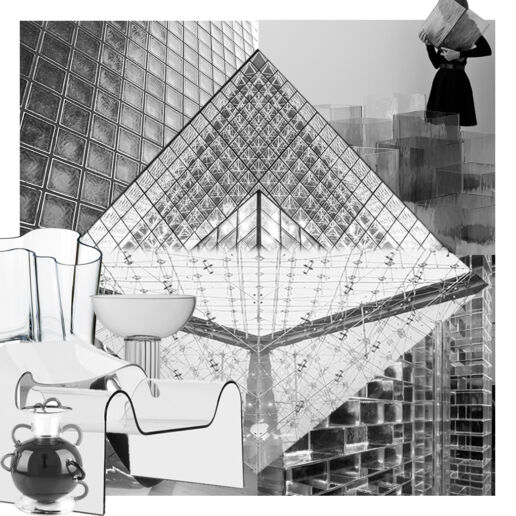Glass
Glass must be one of the best materials available for artistic expression and a long production process lies behind its lucent appearance. If glass is capable of confining Italian architect Ettore Sottsass, the name behind more than 200 rare glass objects, between the personas of artist and designer, then imagine the power it can have over us. Who knows, maybe glass only becomes a work of art in the hands of master craftsmen who have cracked its secret.
Being transparent, opaque, non-conducting and recyclable makes glass an indispensable material in our lives. Historically, glass was first made in Syria, Mesopotamia and Egypt. The first known examples of glass are Ancient Egyptian beads. Today this brittle but durable material is used from tableware to vases, lighting fixtures to jewellery, industry to construction. Composed of sand, sodium carbonate and lime, glass is created by melting silica sand mixed with sodium carbonate or potash. This intriguing material is soft when hot and hard when cold and, throughout history, numerous techniques have been developed to shape it.
OTTOMAN GLASS MAKING
The oldest record of Turkish glassmaking dates back to the 16th century. I was captivated to find out that the Ottomans had a special team of artists called “Ehl-i hiref” working in the Topkapı Palace and that the glass makers in the team were called “Camgeran”. Staining, engraving, cutting and moulding were some of the glassmaking techniques practiced by the Ottomans which confirms that glass was an industry and artform in the Empire. Unsurprisingly, Istanbul was the centre of glassmaking. There are historic documents about the construction of the Süleymaniye Mosque with details about the work of glassmakers. The glass workshops were restructured in the 18th century following the opening of new facilities in Çubuklu. The “çeşm-i bülbül (nightingale’s eye)” made in Beykoz is one of the most well-known items in the history of Turkish glassmaking which ideally portrays Ottoman patterns and forms.
If the topic is glass, then the Cam Ocağı (Glass Furnace) at Riva, Istanbul is be the first place that comes to mind. Home to contemporary glassworks and several workshops, Cam Ocağı is a centre that allows the public to get a better understanding of glass and helps the development of artistic glassmaking. As Turkey’s first glass arts museum that opened in 2007, the Contemporary Glass Arts Museum in Eskişehir is a centre that hosts the works of many glass artists.
ISLAND OF GLASS
Glassmaking reached Thrace, Germany, Spain and Britain after glass windows became widespread in Rome. Yet, the main centres that developed glass art were Venice and Murano. Venetian glass production spread throughout Europe and especially in Germany during the 15th and 16th centuries.
Concerned about the risk of fires from the hot furnaces used to make glass, the Venetian Palace issued a decree to remove workshops from the city which resulted in glassmakers moving to Murano Island. For the last 800 years this island has become the centre of glassmaking. One of the highlights on the island is the Museo Del Vetro (Glass Museum). The world-famous Murano chandeliers have been interpreted by countless designers and artists. In my opinion, one of the most iconic of them are Gio Ponti’s modern chandeliers designed in 1946. Ettore Sottsass was another designer who came to Murano. Collaborating with glassmakers during the 1940s, the architect made unique designs made of glass and crystal. In 2017, an exhibition called “The Glass” was held in Venice to commemorate the centenary of Sottsass’ birth. The Italian architect’s multi-coloured glass designs create a fluid perception of art.
THE MOST INNOCENT OF STONES
So many different works are created with glass. One of them is the limited glass blown Ruutu vase collection made by Ronan & Erwan Bouroullec. The French Bouroullec brothers find perfection boring, so they reinterpreted a very familiar form using a fluid material like glass. Watching each vase being made by 7 glass workers over a period of 24 hours is more like a show. Another interesting example is Japanese design company Nendo’s founder Oki Sato’s glass chair made for WonderGlass which was inspired by the working methods of craftsmen. The idea behind the design is to watch glass freely take shape with only the pull of gravity.
Beautifully described by Jean Jacques Rousseau as the “most innocent of stones”, glass was originally used in windows. Built in 1851 for the Great Exhibition, London’s Crystal Palace boasted the largest glass surface on a building of the time. Whereas the Victorian period Oriel Chambers (1864) was the first building in the world to feature a metal framed glass curtain wall.
SKIN & BONES
Ludvig Mies Van der Rohe is probably the pest person to express glass material in early architecture. After WWI, the German architect started to work on skyscrapers. In 1921, he designed a unique glass clad skyscraper. The design was about creating a semi-translucent façade by using supportive steel frames on the interior to free the exterior from its function as a load-bearer. After that, Mies van der Rohe’s buildings came to be known as “Skin & Bones Architecture”. Famed for his aphorisms, the architect designed the most minimalist house of its time back in 1945. As the definition of the term “Less is More”, the glass building resting on 8 legs consists of a single room divided with separators.


